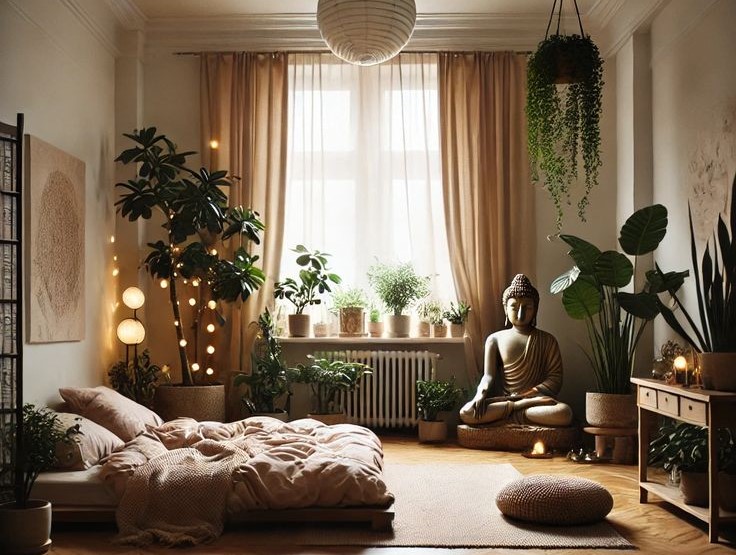In today’s fast-paced world, creating a Zen space at home has become more essential than ever. A Zen-inspired home offers a refuge from the chaos of everyday life, providing a calming environment to relax, recharge, and find inner peace. Drawing inspiration from Zen Buddhism, this style focuses on simplicity, mindfulness, and a deep connection with nature.
As our homes evolve into places where we live, work, and unwind, having a designated Zen space isn’t just about aesthetics—it’s a vital component for emotional balance and spiritual well-being. Whether you’re looking to transform an entire room or just create a small peaceful corner, designing a Zen space at home can help you achieve mental clarity, reduce stress, and enhance your overall well-being.

Whether you’re looking to transform an entire room or just create a small peaceful corner, designing a Zen space at home can help you achieve mental clarity, reduce stress, and enhance your overall well-being.
Key Elements of Zen Space Decor
1. Minimalism: The Foundation of Your Zen Space at Home

The core principle of Zen is simplicity. To create a Zen space, declutter and keep only what truly serves a purpose. Minimalist home decor, which we explored in our previous blog, shares similar ideals — focusing on clean lines, neutral colors, and functionality. The goal is to create an environment where you can feel at ease, without distractions.
- Tip: Use furniture with simple designs, avoiding excessive ornamentation. Opt for pieces that are both practical and aesthetically pleasing.
Why it works: A minimalist setting reduces visual noise, allowing your mind to rest. It clears away chaos and brings attention to what matters most—presence and peace.
2. Natural Materials: Building a Zen-Inspired Home Environment
Zen spaces emphasize a connection to nature. Natural materials like wood, stone, bamboo, and cotton are perfect for creating a soothing and grounded environment. These materials not only enhance the aesthetic but also promote a sense of peace and balance.
- Example: Wooden furniture, stone planters, or a bamboo rug will work wonders in adding a natural touch to your Zen room.

This concept also ties in beautifully with the Japandi style, which integrates natural materials for a minimalist, yet inviting, atmosphere.
Pro Tip: Choose unfinished or matte finishes to maintain the raw, organic feel. Avoid plastic or glossy items that disrupt the earthy ambiance of your Zen space.
3. Bringing Nature Indoors to Enrich Your Zen Space
A key feature of Zen is bringing nature into your living space. Plants, flowers, and natural elements like stones or water features help to cleanse the air and provide a calm atmosphere. According to our blog on “Integrating Greenery into Your Living Space“, indoor plants are essential for improving air quality and adding tranquility to any room.
- Tip: Incorporate easy-care plants like succulents, bamboo, or bonsai trees. A small indoor fountain or a peaceful water feature can also add soothing sounds to your space.
Why it works: These natural elements help to ground your energy, promote mindfulness, and create a living connection to the environment around you.
4. Soft Lighting Ideas for a Peaceful Zen Room

Zen spaces thrive in gentle lighting. Natural light is always preferred, but soft, warm artificial lighting can enhance the tranquil atmosphere. Avoid harsh or overly bright lights, and instead opt for lamps or candles that create a warm and inviting glow.
- Tip: Use dimmable lights or paper lanterns to create a soft, peaceful ambiance. Place candles or incense around the room to promote relaxation.
Consider using Himalayan salt lamps or warm LED strips behind furniture for a calming glow that mimics sunset light—perfect for winding down.
5. Open Space and Chi Flow in Zen Home Design
The layout of a Zen space should encourage the free flow of energy (or “Chi”). Avoid overcrowding the room with too much furniture, and ensure there is plenty of space to move freely. A clean, open layout encourages a sense of peace and allows energy to circulate smoothly.
- Tip: Use simple furniture arrangements that allow movement and openness. Avoid blocking doorways or windows, as this could disrupt the flow of Chi.
Arrange furniture asymmetrically and leave floor space bare when possible. Emptiness in Zen is not a void—it’s a source of potential energy and serenity.
Designing a Zen Space in Your Home
Zen Living Room Ideas
The living room is often the heart of the home, so it’s essential to create a peaceful, inviting space. Start with a neutral color palette — soft greys, whites, and earthy tones — and add minimal furniture with clean lines. Incorporate a few plants, such as peace lilies or bamboo, to introduce natural elements.
Add floor cushions for informal seating or a low tea table to encourage mindfulness and unplugged moments with friends or solo reflection.
Zen Bedroom Ideas
For your bedroom, focus on creating a space that encourages relaxation and restfulness. A low-profile bed made from wood, simple bedding in neutral tones, and a few plants or soft lighting will help transform your room into a Zen-inspired retreat. Remember, the bedroom is a place for rest, so avoid clutter and keep the atmosphere serene.
Use blackout curtains in a neutral tone to aid restful sleep and maintain the room’s tranquil energy throughout the night.
Zen Bathroom Ideas
The bathroom is another perfect place to integrate Zen principles. Use natural materials like stone or wood for your fixtures, and consider adding a small indoor water fountain to bring the calming sound of flowing water into your space. Simple, minimalist designs for the sink and shower can contribute to the tranquil, Zen-inspired ambiance.
Introduce eucalyptus bundles in your shower or use essential oils to incorporate aromatherapy into your daily routine.
For more expert advice on designing serene interiors, explore this guide by Architectural Digest on calming home spaces.
Common Mistakes That Disrupt Your Zen Space at Home
While designing your Zen space, it’s important to avoid these common pitfalls:
- Clutter: Keep only essential items in the space. Too much stuff will create chaos and disrupt the peaceful energy.
- Over-decorating: Zen decor values simplicity. Avoid excessive decoration or too many bold patterns.
- Harsh Lighting: As mentioned, harsh lighting disrupts the calm atmosphere. Stick to soft, natural, or ambient lighting.
Bonus Tip: Avoid digital clutter as well—limit screens and unplug unnecessary electronics to enhance presence and mindfulness.
Embrace Peace: Final Thoughts on Zen-Style Home Decor
Creating a Zen space at home is more than just about decor — it’s about creating an environment that nurtures peace, relaxation, and mindfulness. Whether you’re incorporating elements of minimalism or drawing inspiration from the Japandi style, the goal is to make your home a sanctuary where you can unwind and reconnect with yourself.
From selecting earthy textures to arranging your furniture for optimal Chi flow, each decision should align with your intention to invite calm and clarity into your daily life.
Take the time to incorporate these simple principles, and soon your home will be a tranquil haven that promotes mental clarity, calm, and balance.
No matter how big or small your space is, a Zen space can be your personal escape—a retreat that supports healing, stillness, and presence in today’s overstimulated world.
